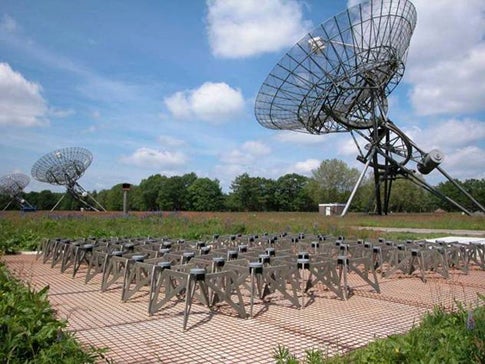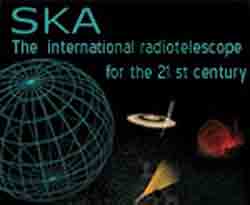ASTRON, one of the world’s leading astronomy research organizations, today announced a new collaborative agreement with IBM® focusing on the design, engineering, and manufacturing of customized, high performance analog and mixed signal processing chips. The high performance, low power usage customized chips will be used in thousands of antennas as part of ASTRON’s project to build a new prototype radio telescope called SKADS/EMBRACE, which will be the precursor for the world’s largest radio astronomy telescope, the Square Kilometer Array (SKA) radio telescope. Financial terms are not being disclosed.
A global community of astronomers is setting out to build the world’s largest radio telescope, called the SKA radio telescope. This extremely powerful survey telescope will have millions of antennas collecting radio signals, forming the equivalent of a 1 sq Km collecting area, and spread over a huge surface area &mdash over 3000 Km wide &mdash about the size of the continental United States. The goal of the SKA radio telescope is to peer deep into space and look at evolving galaxies, dark matter and perhaps even the very origins of the universe &mdash dating back more than 13 billion years.
In order to build this SKA radio telescope, new technologies, functions, and huge advancements in technology will be required that need to be prototyped in pilot project form &mdash hence the SKADS/EMBRACE project &mdash the first step in this journey.
The Netherlands, France, Italy, and Germany are involved in the design and development of SKADS/EMBRACE antenna tiles and there are additional countries that are or will be involved in the engineering and scientific testing of the SKADS/EMBRACE demonstrator.
“A large project such as SKA also requires a close collaboration with major industrial companies such as IBM and with their commitment to this project, they will contribute significantly to a successful outcome,” said Dr. Marco de Vos, ASTRON Research and Development Director.
A team of engineers from both ASTRON and the IBM Technology Collaboration Solutions will work in IBM’s Burlington, Vermont, USA facility on engineering, design, and manufacturing of the customized processors.
“Increasingly, more and more companies across industries must collaborate with others in order to achieve the new level of innovation required for success,” said Raj Desai, Vice President, Aerospace & Defense, IBM Technology Collaboration Solutions. “With access to our deep R&D capabilities, engineering expertise and intellectual property, we can collaborate with ASTRON to develop the customized processors which have the speed, performance and cooling capabilities that will enable ASTRON to focus on the research results they desire.”
The chips will be deployed in pilot antenna tiles and will be used to filter useful information from the radio signals. The SKADS/EMBRACE antenna tiles will be deployed in the North of The Netherlands at the site of the famous Westerbork Radio Synthesis Telescope (WSRT) and in France near Nançay, South of Paris.
IBM has previously collaborated with ASTRON on implementing IBM’s Blue Gene® supercomputer, currently being used to gather and analyze information from ASTRON’s Low Frequency Array (LOFAR) “software telescope” network located in the North of The Netherlands.
Decisions on the final location for the SKA radio astronomy telescope are still to be finalized. Australia and South Africa are the two remaining location options, capable of installing the millions of antennas required for receiving the very weak signals from the universe.
IBM Technology Collaboration Solutions group integrates the skills of IBM engineers, consultants and technical professionals, with IBM’s leading edge technology and access to its intellectual property assets within IBM, to enable a new level of collaborative innovation, research and development between IBM and its clients.











